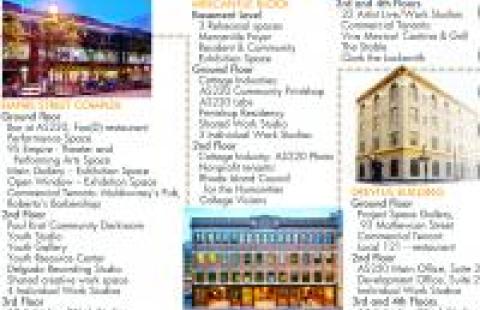What were the project goals?
The overarching goal has been to meet the artistic engagement needs of the broad Rhode Island arts community, especially those whose access to the arts is limited due to economic or other factors, and to use diverse original arts programming to enliven downtown Providence. Within this broad goal, some of the supporting goals have been:
• Build and sustain an Alternative Culture in dialogue with the Dominant Culture.
Create a culture of equity, access and opportunity for all RI artists and art audiences, celebrating freedom, welcoming diverse expression and breaking down our self-imposed socio-economic barriers. Engage with and influence the Dominant Culture.
• Increase arts activity and exposure.
Increase diverse art activity in the downtown area by providing ready and welcome access to performing and exhibiting opportunities;
• Build a strong residential community.
Build a downtown residential live/work artist community by providing a range of affordable housing and studio opportunities to artists within a mixed-use urban environment;
• Increase learning opportunities in the arts.
Increase arts practice by providing learning opportunities to the broad community of learners, especially to those with limited access, with a focus on marginalized youth.
Have they changed over time?
The goals have not changed, but the implementation strategies have adjusted according to changing market conditions and opportunities. The overarching goal of providing access and opportunity has continued to guide our supporting goals and strategies.
• Build and sustain an Alternative Culture in dialogue with the Dominant Culture.
To maintain equitable access, our programming and communications have adjusted to meet the interests of a changing community.
• Increase arts activity and exposure.
The demand for exhibiting and presenting opportunities has grown, as demonstrated by an approximate 3-year waiting list for our galleries, so our gallery program has responded by expansion from two galleries prior to 2006 to three galleries in 2006 and to four in 2010. Performing opportunities have expanded from one performance space prior to 2006 to two performing spaces in 2012.
• Build a strong residential community.
Based on local demand, our residential (live/work) community has grown from 12 units prior to 2006 to 26 units in 2006 to 48 units in 2010. Work studios have grown from 3 prior to 2006 to 7 in 2006 to 10 in 2010.
• Increase learning opportunities in the arts.
Based on demand and additional space, we have been able to expand learning opportunities throughout AS220 Youth, the AS220 Industries, and are now expanding educational programming within our performance and theater arts program.
Who are the project partners and stakeholders?
Partners and stakeholders are:
Policy leaders and funders /
The City of Providence, especially the Department of Arts, Culture + Tourism, the Rhode Island State Council on the Arts, the Rhode Island Foundation, the Rhode Island Council on the Humanities, the Ford Foundation, DeVos Institute of Arts Management at the Kennedy Center, Kresge Foundation, Surdna Foundation, the RI Department of Children, Youth and Families, the RI Department of Education, RI department of Labor, the Corporation for National Service, the Providence Downtown Improvement District.
Program partners /
Trinity Repertory Company, Urban Collaborative Accelerated Program, Institute for the Study and Practice of Nonviolence, Providence Youth Arts Collaborative, EAW (Eastern Acoustic Works), Johnson and Wales University, MIT Center for Bits and Atoms.
